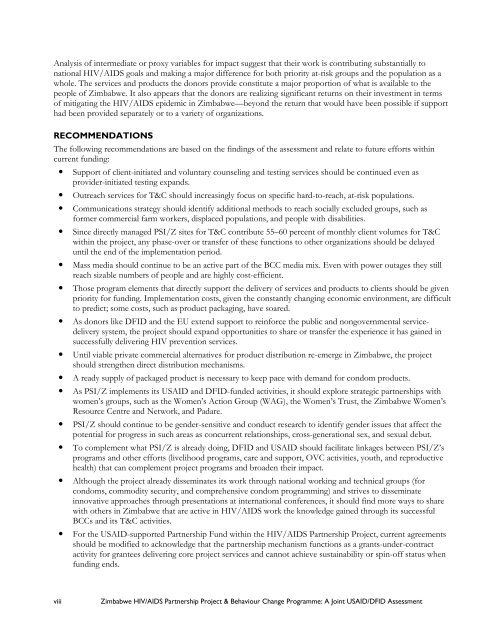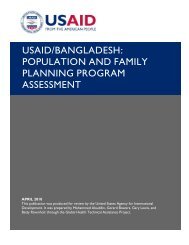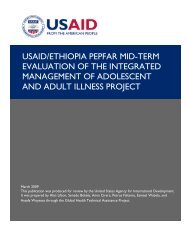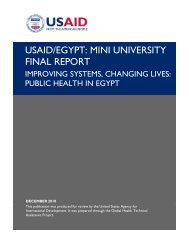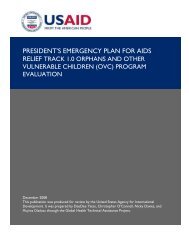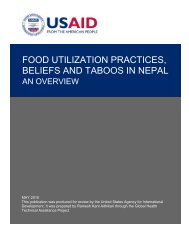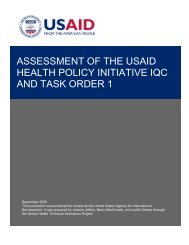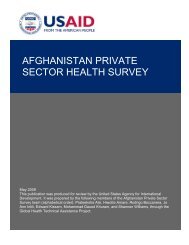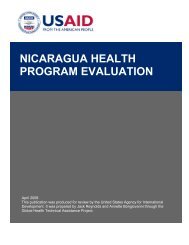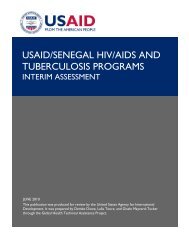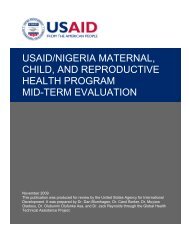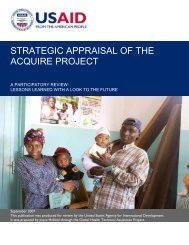Zimbabwe HIV/AIDS Partnership Project & Behaviour Change
Zimbabwe HIV/AIDS Partnership Project & Behaviour Change
Zimbabwe HIV/AIDS Partnership Project & Behaviour Change
- No tags were found...
You also want an ePaper? Increase the reach of your titles
YUMPU automatically turns print PDFs into web optimized ePapers that Google loves.
Analysis of intermediate or proxy variables for impact suggest that their work is contributing substantially tonational <strong>HIV</strong>/<strong>AIDS</strong> goals and making a major difference for both priority at-risk groups and the population as awhole. The services and products the donors provide constitute a major proportion of what is available to thepeople of <strong>Zimbabwe</strong>. It also appears that the donors are realizing significant returns on their investment in termsof mitigating the <strong>HIV</strong>/<strong>AIDS</strong> epidemic in <strong>Zimbabwe</strong>—beyond the return that would have been possible if supporthad been provided separately or to a variety of organizations.RECOMMENDATIONSThe following recommendations are based on the findings of the assessment and relate to future efforts withincurrent funding:• Support of client-initiated and voluntary counseling and testing services should be continued even asprovider-initiated testing expands.• Outreach services for T&C should increasingly focus on specific hard-to-reach, at-risk populations.• Communications strategy should identify additional methods to reach socially excluded groups, such asformer commercial farm workers, displaced populations, and people with disabilities.• Since directly managed PSI/Z sites for T&C contribute 55–60 percent of monthly client volumes for T&Cwithin the project, any phase-over or transfer of these functions to other organizations should be delayeduntil the end of the implementation period.• Mass media should continue to be an active part of the BCC media mix. Even with power outages they stillreach sizable numbers of people and are highly cost-efficient.• Those program elements that directly support the delivery of services and products to clients should be givenpriority for funding. Implementation costs, given the constantly changing economic environment, are difficultto predict; some costs, such as product packaging, have soared.• As donors like DFID and the EU extend support to reinforce the public and nongovernmental servicedeliverysystem, the project should expand opportunities to share or transfer the experience it has gained insuccessfully delivering <strong>HIV</strong> prevention services.• Until viable private commercial alternatives for product distribution re-emerge in <strong>Zimbabwe</strong>, the projectshould strengthen direct distribution mechanisms.• A ready supply of packaged product is necessary to keep pace with demand for condom products.• As PSI/Z implements its USAID and DFID-funded activities, it should explore strategic partnerships withwomen’s groups, such as the Women’s Action Group (WAG), the Women’s Trust, the <strong>Zimbabwe</strong> Women’sResource Centre and Network, and Padare.• PSI/Z should continue to be gender-sensitive and conduct research to identify gender issues that affect thepotential for progress in such areas as concurrent relationships, cross-generational sex, and sexual debut.• To complement what PSI/Z is already doing, DFID and USAID should facilitate linkages between PSI/Z’sprograms and other efforts (livelihood programs, care and support, OVC activities, youth, and reproductivehealth) that can complement project programs and broaden their impact.• Although the project already disseminates its work through national working and technical groups (forcondoms, commodity security, and comprehensive condom programming) and strives to disseminateinnovative approaches through presentations at international conferences, it should find more ways to sharewith others in <strong>Zimbabwe</strong> that are active in <strong>HIV</strong>/<strong>AIDS</strong> work the knowledge gained through its successfulBCCs and its T&C activities.• For the USAID-supported <strong>Partnership</strong> Fund within the <strong>HIV</strong>/<strong>AIDS</strong> <strong>Partnership</strong> <strong>Project</strong>, current agreementsshould be modified to acknowledge that the partnership mechanism functions as a grants-under-contractactivity for grantees delivering core project services and cannot achieve sustainability or spin-off status whenfunding ends.viii<strong>Zimbabwe</strong> <strong>HIV</strong>/<strong>AIDS</strong> <strong>Partnership</strong> <strong>Project</strong> & <strong>Behaviour</strong> <strong>Change</strong> Programme: A Joint USAID/DFID Assessment


